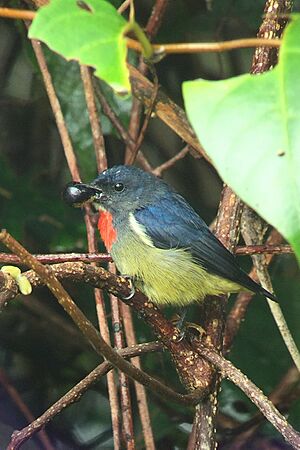Black-sided flowerpecker facts for kids
Quick facts for kids Black-sided flowerpecker |
|
|---|---|
 |
|
| Male with Medinilla speciosa berry | |
| Conservation status | |
| Scientific classification | |
| Genus: |
Dicaeum
|
| Species: |
monticolum
|
| Synonyms | |
|
|
The black-sided flowerpecker (Dicaeum monticolum) is a tiny bird. It is also called the Bornean flowerpecker. This bird lives only on the island of Borneo. You can find it in the mountains, usually above 1,000 meters (about 3,300 feet).
Male and female black-sided flowerpeckers look different. The male has shiny blue-black feathers on top. He has a bright red throat and chest. His belly is dark grey and white. The female is olive-green on top and grey underneath.
These birds live in different kinds of forests. They can be found in mountain forests, heathland forests, and even gardens. They mostly eat small fruits, especially mistletoe berries. They also enjoy seeds, nectar, and small bugs. Black-sided flowerpeckers build their nests from moss. They hide the nests with lichens and line them with soft tree fern material.
Scientists believe this bird is not currently in danger. Its population is thought to be stable. However, cutting down forests for palm plantations could affect them.
Contents
What is a Black-sided Flowerpecker?
The black-sided flowerpecker is a very small passerine bird. It is only about 8 centimeters (3 inches) long. Its weight has not been recorded. Like many flowerpeckers, the male and female look different. The male is much more colorful.
Male Black-sided Flowerpeckers
The male has shiny blue-black feathers on his back and wings. His face and neck sides are black. He has a white chin. His throat and chest are bright scarlet red. This red area has a grey-black border. His upper belly is dark grey, and his lower belly is white. The feathers under his tail are yellowish.
Female Black-sided Flowerpeckers
The female has olive-green feathers on her upper body. Her underside is grey. She has yellowish feathers on her rump and a whitish throat. Young birds look similar to the female. They are more olive-grey below. Young males might have some red on their chest. Both male and female birds have dark brown eyes and black beaks. Their feet are dark grey or brown.
Where Do Black-sided Flowerpeckers Live?
The black-sided flowerpecker lives only in the mountain forests of Borneo. They are usually seen above 1,000 meters (3,300 feet). Some have been found as high as 2,540 meters (8,330 feet). On very tall mountains like Kinabalu, they can sometimes be seen as low as 460 meters (1,500 feet).
Most records of these birds come from Malaysia's states of Sabah and Sarawak. They are found in different forest types. This includes old-growth forests, regrowing forests, and heathland forests. They can also be found in scrub areas and gardens.
What Do Black-sided Flowerpeckers Eat?
Like all flowerpeckers, the black-sided flowerpecker mainly eats fruit. They especially love mistletoe berries. They also eat other small fruits, like those from the Medinilla speciosa plant. Their diet also includes seeds, nectar, and various small invertebrates (bugs). They usually look for food close to the ground. Sometimes, they feed higher up in the trees.
How Do Black-sided Flowerpeckers Breed?
Not much is known about how black-sided flowerpeckers raise their young. Young birds have been seen between November and February. Adults ready to breed have also been found during this time.
Their nest is made of moss. It is lined with the soft inside part of tree ferns. They use lichens to camouflage the outside of the nest. This helps to hide it from predators. The eggs of this bird have not yet been described by scientists.
Are Black-sided Flowerpeckers in Danger?
The International Union for Conservation of Nature (IUCN) says the black-sided flowerpecker is a species of least concern. This means it is not currently considered endangered. We don't know exactly how many there are. However, their numbers are thought to be decreasing slowly. The population is not broken up into small groups.
The species is said to be common in many parts of its home range. But, cutting down forests for oil palm plantations could harm them. Studies show that these birds are only found in small numbers in palm groves. They stay close to the edge of the forest. They are not found deep inside large palm groves.
Images for kids



